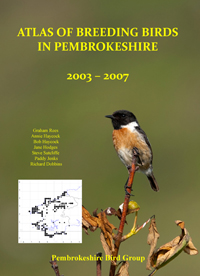Breeding resident
Mathew (1894) and Lockley et al. (1949) agreed that the Carrion Crow was a common resident.
They were formerly persecuted throughout Pembrokeshire: 134 were killed on the Cawdor Estate at Stackpole in 1821 (Carmarthen County Records Office, Box 1-234) and Lloyd counted 150 on a gibbet at Slebech in 1930. Although still sometimes shot by game preservers and shepherds, they are now largely unmolested.
They breed over a wide area, mostly in trees but also on cliff ledges, and have occupied most of the offshore islands (see map). They used to breed on Ramsey, but were eradicated, at least temporarily, by trapping during the 1980s, and have declined at Skomer, perhaps due to increased competition for food and nest sites from Magpies. The distances between nests were noted in a number of areas of the county during 1986 and 1987 and used to estimate an average density of 40-45 pairs per tetrad, suggesting a county population of 18,000-21,000 pairs.
Groups of non-breeding birds, sometimes up to 100 strong, gather on the estuaries during the summer to feed on shellfish, notably at Fowborough and the Gann. This habitat is also utilised by family parties after the breeding season and throughout the winter, when up to 200 may gather.
Lockley (1957) stated that roosting flocks of up to 100 were common in Pembrokeshire but most modem records refer to 60 or less, though 208 were counted gathering at Dowrog in November 1988.
They are perhaps partial migrants, judging by records of birds overflying remote offshore areas such as the Smalls or flying in or off the sea at headlands, and a nestling ringed at Bardsey was later found in north Pembrokeshire.
Hooded Crows, which occur most years on the islands of Ramsey, Skokholm and Skomer, or at the coast in localities such as Fishguard Harbour, St David's, Solva and Martin's Haven, undoubtedly come from elsewhere, most likely from Ireland. They have turned up in every month and individuals have sometimes made prolonged stays. One which wintered at Fishguard Harbour in 1986/87 was seen displaying in the spring and may have attempted to breed.

Fieldwork 1984-88 (based on 478 tetrads)
Red = breeding confirmed = 390
Orange = breeding probable = 22
Yellow = breeding possible = 47
Total tetrads in which registered = 459 (96%)
Donovan J.W. & Rees G.H (1994), Birds of Pembrokeshire
 Tuesday, July 23, 2013 at 5:56PM
Tuesday, July 23, 2013 at 5:56PM  1949 BoP in
1949 BoP in  Carrion Crow
Carrion Crow 





